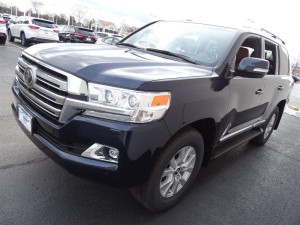
Dealer Photos
Tech specs not available at this time
Thank you for submitting your offer to us. Our staff will get back to you promptly with a response to your request: 2020 Toyota Tundra SR5.
2020 Toyota Tundra
Discount Toyota Prices
Low Tundra Lease Payments
All Color Options Available Nationwide Delivery
The 2020 Toyota Tundra is the oldest pickup truck in this class, but it has the most standard safety technology and solid off-road cred. Despite its aging design and powertrain, the Tundra offers a potent and proven V-8 engine and a stylized TRD Pro model. The latter enhances the 2020 Tundra's ruggedness with a lifted suspension and other exclusive trail-ready equipment. Lesser TRD models are also built to take the path less traveled, which is where the Tundra works best. Otherwise, its lowly fuel economy and unrefined road manners make it our least favorite full-size truck to drive on a daily basis. Still, the Tundra's available crew cab has a huge back seat and loads of useful storage space. Although it's not one of the best new pickup trucks, the 2020 Tundra will satisfy outdoorsmen and those who glorify the Toyota badge. The big news is that the 2020 Tundra lineup no longer includes the previously standard 4.6-liter V-8. Instead, every model is now fitted with the 5.7-liter V-8—the flex-fuel version also has been dropped. The Tundra SR5 adds new options such as push-button start with passive entry, leather surfaces, and front bucket seats with a power-operated driver's seat. Toyota finally makes Apple CarPlay and Android Auto capability available on most models. The Toyota Tundra's base price makes it one of the cheapest full-size trucks you can buy with an extended cab and a V-8 engine. We think the SR5 model is the best value. The crew cab option adds $1695, but it's only available with a 5.5-foot bed. We'd stick with the standard 6.5-foot bed and add four-wheel drive for a good mix of utility and capability. The TRD Off-Road package brings a host of superficial and mechanical upgrades. Highlights include a bigger touchscreen with navigation, mobile hotspot, and Apple CarPlay and Android Auto capability. It also adds a larger fuel tank for extended driving range, skid plates to protect the underbody, off-road shock absorbers, and 18-inch wheels with chunkier tires. Compared with newer and more advanced powertrains, the Tundra's engine and transmission are prehistoric. The standard 5.7-liter V-8 is good for 381 horsepower and 401 lb-ft of torque. Rear-wheel drive is standard and four-wheel drive is optional for both setups, but not for all cab-and-bed configurations. The Tundra's engine is reasonably peppy but emits an unsatisfyingly weak exhaust note, and its six-speed automatic shifts rather slowly. While it isn't terrible to drive, the last Tundra we tested felt archaic and a bit off the pace compared with lighter and more powerful competitors. Due to the Tundra's firm suspension, every bump is transmitted into the cabin, which makes for a lumpy ride when driving over rough surfaces. The upgraded shocks on the TRD Pro and models with the TRD Off-Road package marginally improve the ride quality, as well as help to better manage body motions in corners. The Tundra's light, numb steering isolates the driver from the road and requires constant corrections at highway speeds. The Tundra's brakes are adequate and can haul the truck down from 70 mph in a so-so 190 feet, but the brake pedal returns little feedback and has inconsistent travel. Towing and Payload Capacity The Tundra's maximum tow rating of 10,200 pounds will be more than most people need, and even its least capable configuration can tug at least 8800 pounds. Fuel Economy and Real-World MPG The Tundra has the worst fuel economy in its class. While its competitors don't exactly sip fuel either, the EPA rates its V-8 with four-wheel drive at 13 mpg city and 17 mpg highway. The last one we tested matched its highway rating on our 200-mile fuel-economy test, but that figure is still lower than all the other pickups we've tested. Interior, Comfort, and Cargo The Tundra's interior is spacious and dotted with oversized features, but it's an outdated presentation and the materials in most models feel cheap and rubbery. Although its rear-seat legroom is among the best for crew cabs, the quality and layout of the Tundra's cabin are unimpressive, as well as short on amenities found in the fresher competition. The only salvation is the 1794 Edition, which has luscious saddle-brown leather-trimmed seating and ultrasuede accents. The Tundra's front roof pillars are wide at the base and create a sizable blind spot, but the large rear windows of the crew cab do offer adequate visibility. An abundance of cargo and storage space is expected with a pickup. While the Toyota is merely adequate in most areas, our testing revealed that the cavernous crew cab is able to hold 21 carry-on suitcases with its rear seat folded, two more than any other pickup. Deep but narrow door pockets prevent storing larger items, but the extended cab—called Double Cab—does have a storage compartment under the rear seat that's not available in other cabs. The Tundra has three cargo-bed lengths. The shortest is 5.5 feet and is only available with the crew cab. The extended cab can pair with a 6.5- or an 8.1-foot bed.

























